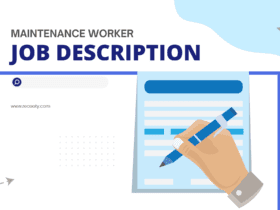

Are you searching for a visionary leader to steer your company toward financial prosperity? Look no further! In this insightful blog post, we will walk you through the essential elements of a compelling CEO job description.
We will delve into the essential components of a CEO job description, highlighting the key responsibilities, qualifications, and skills required for this influential leadership role. Discover how to attract top executive talent and optimize your company’s leadership structure for maximum impact.
Don’t like this Job Description?
Create your own job description with AI in seconds
Table of Contents
How to Write the CEO Job Description?
Writing a compelling CEO job description requires careful consideration and attention to detail. Here’s a step-by-step process to guide you:
- Conduct a thorough job analysis: Start by analyzing the CEO role within your organization. Understand the key responsibilities, objectives, and outcomes expected from the position. This analysis will form the foundation of your job description.
- Gather relevant information: Consult with stakeholders, including board members, executive team members, and current or former CEOs, to gather valuable insights about the role. Understanding the strategic vision, challenges, and expectations will help you create a comprehensive job description.
- Structure and language: Structure your job description in a logical manner, using clear headings and subheadings. Use concise and compelling language to highlight the exciting aspects of the CEO role and your organization’s mission.
- Include essential details: Clearly state the job title, department, and reporting structure. Describe the major responsibilities, objectives, and outcomes of the role. Specify the required qualifications, skills, and experience. This information will help potential candidates determine if they are a good fit for the position.
What Does a CEO Do?
The role of a CEO is of utmost importance within an organization. As the highest-ranking executive, the CEO is responsible for providing strategic leadership, managing resources, driving business growth, and ensuring the overall success of the organization.
The CEO sets the vision and direction, develops and executes business strategies, and fosters a positive corporate culture. CEOs have a significant impact on the organization’s growth, profitability, and long-term success.
CEO Roles & Responsibilities:
The responsibilities of a CEO are diverse and encompass various aspects of leadership, strategy, and decision-making. Here’s a brief overview of the primary responsibilities of a CEO:
Primary Responsibilities
Provide visionary leadership: Develop and communicate the organization’s strategic vision, mission, and values. Set clear goals and objectives for the organization and ensure their alignment with stakeholders’ interests.
- Develop and execute business strategies: Identify opportunities for growth, expansion, and innovation. Develop comprehensive business strategies and plans to achieve organizational objectives. Continuously monitor market trends and competitive landscape to make informed strategic decisions.
- Drive financial performance: Ensure the financial health and stability of the organization. Develop and manage budgets, monitor financial performance, and implement strategies to improve profitability and operational efficiency.
- Foster a positive corporate culture: Create a positive work environment that aligns with the organization’s values. Foster a culture of collaboration, accountability, and continuous improvement. Lead by example and promote diversity, inclusion, and ethical business practices.
- Build and nurture relationships: Establish strong relationships with key stakeholders, including board members, investors, employees, customers, and community leaders. Represent the organization and act as its spokesperson in external engagements.
- Recruit and develop top talent: Attract, recruit, and retain high-performing executives and employees. Develop effective talent management strategies, mentor and coach employees, and foster a culture of learning and development.
These primary responsibilities are essential for the CEO to drive the organization toward success, growth, and sustainability.
Additional Responsibilities
In addition to the primary responsibilities, a CEO may have additional duties that contribute to the overall functioning of the organization. Some examples include:
- Participating in board meetings and presenting reports and updates.
- Establishing and maintaining relationships with strategic partners, government agencies, and industry associations.
- Leading or participating in fundraising activities and investor relations.
- Overseeing regulatory compliance and risk management initiatives.
- Representing the organization at industry conferences, events, and public speaking engagements.
These additional responsibilities may vary depending on the organization’s size, industry, and specific needs. Including them in the job description gives candidates a comprehensive understanding of the role’s scope.
CEO Requirements:
To excel as a CEO, certain qualifications, skills, and competencies are necessary. Here are the key requirements you can consider adding to your job description for this role:
Education & Experience
- A bachelor’s degree in business administration, management, or a related field. An MBA or advanced degree is often preferred.
- Extensive experience in executive leadership positions, preferably as a CEO or in a similar role.
- Proven track record of successfully leading and growing organizations.
- Experience in strategic planning, financial management, and business development.
Skills & Competencies
- Strong leadership and decision-making abilities.
- Excellent strategic thinking and problem-solving skills.
- Exceptional communication and interpersonal skills.
- Ability to build and maintain relationships with stakeholders.
- Financial acumen and understanding of business operations.
- Visionary thinking and the ability to inspire others.
- Adaptable and agile in a fast-paced and dynamic environment.
- These requirements set the foundation for finding a CEO who can effectively lead the organization and drive its success.
CEO Job Description Template:
To write an effective job description for the role of a CEO, consider the following:
- Use a proper format: Start with a clear job title, department, and reporting structure. This provides a quick overview of the position within the organization.
- Major responsibilities and objectives: Describe the primary responsibilities and objectives of the role in a concise manner. Use bullet points to enhance readability and highlight key points.
- Required qualifications, skills, and experience: Clearly specify the required education, experience, certifications, and skills. Be specific about the level of experience and any preferred qualifications.
Here is an example of a well-structured job description for a CEO:
[Job Title]
Chief Executive Officer (CEO)
[Department]
Executive Leadership
[Reporting Structure]
Reports to the Board of Directors
[Job Description]
[Company Name] is looking for a visionary and dynamic leader to fill the role of CEO. This is a remarkable opportunity to drive strategic growth, foster innovation, and steer our organization toward unprecedented success. If you possess a track record of executive leadership, a passion for driving change, and the ability to inspire teams, we invite you to join us on this exciting journey.
Responsibilities:
- Provide visionary leadership and develop the organization’s strategic direction.
- Develop and execute business strategies to achieve growth and profitability.
- Drive financial performance and ensure the organization’s financial health.
- Foster a positive corporate culture and promote diversity and inclusion.
- Build and nurture relationships with stakeholders and represent the organization externally.
- Recruit, develop, and retain top talent to achieve organizational objectives.
Requirements:
- Bachelor’s degree in business administration or a related field. MBA preferred.
- Extensive experience in executive leadership positions, including CEO roles.
- Proven track record of successful organizational growth and leadership.
- Strong strategic thinking, communication, and interpersonal skills.
- Financial acumen and understanding of business operations.
Frequently Asked Questions (FAQs):
What are the primary responsibilities of a CEO?
The primary responsibilities of a CEO include providing visionary leadership, developing and executing business strategies, driving financial performance, fostering a positive corporate culture, building relationships with stakeholders, and recruiting top talent.
What qualifications are required for a CEO role?
A CEO typically requires a bachelor’s degree in business administration or a related field. Extensive experience in executive leadership roles, including CEO positions, is essential. An MBA or advanced degree is often preferred.
What skills are important for a CEO?
Important skills for a CEO include strong leadership abilities, strategic thinking, decision-making, communication, and interpersonal skills. Financial acumen and the ability to build and maintain relationships are also crucial.
Can I customize the job description template for our organization?
Absolutely! The provided job description template serves as a starting point. Feel free to customize it to align with your organization’s specific needs, values, and industry requirements.
Conclusion
Crafting an effective CEO job description is a critical step in attracting qualified candidates who can drive your organization’s success. By following the step-by-step process, structuring the job description appropriately, and highlighting the key responsibilities and requirements, you can streamline your hiring process and find the right CEO to lead your organization into the future.
Utilize the provided templates, tailor them to your organization’s needs, and attract top talent for this pivotal role. Invest time and effort into creating a compelling job description, and you’ll increase your chances of finding a CEO who will make a lasting impact on your organization’s growth and success.





















